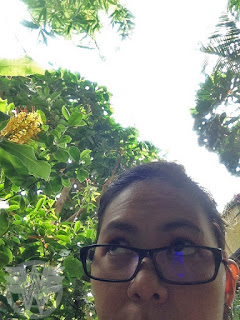Every summer, once a week, the Barbican opens a very special section to the garden-loving public. The Barbican Conservatory is London's second-largest greenhouse, next to Kew Gardens. Unlike the greenhouses in Kew Gardens, it's relatively small, split into several levels, and is in the heart of the city.
The Conservatory is only open Sundays and bank holiday Mondays. The rest of the time it's a venue hire, booked solid for weddings, corporate parties and other events. A fine sunny day with not too many other visitors was the perfect opportunity for some wide shots!
The Conservatory houses tropical fish, terrapins and turtles, and over 2000 tropical plant species, including several from our own homeland. All the green things creeping over the multi-level concrete balconies, exuding a damp perfume, felt like home!
The fish ponds were favourite spots, with koi of many sizes, including some big gold and silver monsters. A narrow channel under an arched bridge led from the main lake to a much smaller viewing pond where the fish seemed to vie for attention.

Even the most beautiful garden needs more work than a natural ecosystem. The trick is to disguise the ugly machinery that keeps the paradise breathing. Still, curious visitors can examine part of the irrigation system, a concrete box and two tubs of mysterious piping tucked behind a pair of trellised pillars.
Some beloved and familiar plants called out to us along the path: the gabi, known to the rest of the world as the taro, nodding over a tiled pool of rushing water...
...the bougainvillea, mainstay of middle-class tropical homes...
...and the gumamela, or hibiscus, which displayed some of the most vibrant blooms in the gardens. This is the national flower of the Philippines, and one of our favourites.
There are benches in sunnier spots for those tired of climbing the stairs or ambling along the path, or if you just want to look at plants or take closer pictures of the fish.
A flight of stairs took us up to a viewing walkway and an arid room for desert plants. A long rocky structure ran along the wall halfway up - it turned out to be a turtle pond! Little black turtles and terrapins cooled in the shadowed water or warmed themselves on rocks.
The desert room is one of the Barbican's main attractions. But for the wonder | wander | women it also has personal significance: memories of Sedona in Arizona, one of the most beautiful places in the world.
This greenhouse, like the tropical world below, was a bubble of thriving desert life. It looked so perfect we expected to see a lizard skitter across the rocks or a snake curled under one of the succulents.
And what succulents! Listen, readers, the wonder | wander | women love cacti. We LOVE cacti. We love their alien shapes bulging with juice, we love their velvety texture and furry-looking spikes, we love the sheer variety of them. Growing out of the barren sand and rock, they crowd in front of our eyes, seeming to yell 'Look! I am ALIVE!'
This monster aloe was so alive it could have reached out with its tentacles and seized one of us to feed itself.
Back downstairs we took another turn round the tropical environment, unwilling to leave. We wandered, taking more pictures and doing a little botanical drawing to watercolour later, reading the labels and notices of the plants: this one from Asia, that one from Africa or South America.
After another hour we finally staggered outside, overwhelmed with green, and had to sit for a while among the bricks and concrete of the Barbican, getting our city legs back. It's great to know that there's a living heart in this baked cement construction, ready for visitors to come and fall in love with it.


























No comments:
Post a Comment
Note: Only a member of this blog may post a comment.